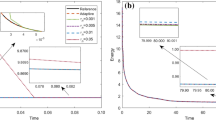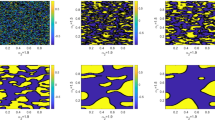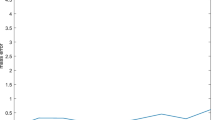Abstract
In this paper, we consider a fast explicit operator splitting method for a fractional Cahn-Hilliard equation with spatial derivative \((-{\varDelta })^{\frac {\alpha }{2}}\)(α ∈ (1,2]), where the choice α = 2 corresponds to the classical Cahn-Hilliard equation. The original problem is split into linear and nonlinear subproblems. For the linear part, the pseudo-spectral method is adopted, and thus an ordinary differential equation is obtained. For the nonlinear part, a second-order SSP-RK method together with the pseudo-spectral method is used. The stability and convergence of the proposed method in L2-norm are studied. We also carry out a comparative study of two classical definitions for fractional Laplacian \((-{\varDelta })^{\frac {\alpha }{2}}\), and numerical results obtained using computational simulation of the fractional Cahn-Hilliard equation for a variety of choices of fractional order α are presented. It is observed that the fractional order α controls the sharpness of the interface, which is typically diffusive in integer-order phase-field models.










Similar content being viewed by others
References
Cahn, J., Hilliard, J.: Free energy of a nonuniform system. I: Interfacial energy. J. Chem. Phys. 28, 258 (1958)
Cahn, J., Hilliard, J.: Free energy of a nonuniform system. II: Thermodynamic basis. J. Chem. Phys. 30, 1121–1135 (1959)
Chan, P.K., Rey, A.D.: A numerical method for the nonlinear Cahn-Hilliard equation with nonperiodic boundary conditions. Comp. Mater. Sci. 3, 377–392 (1995)
Dolcetta, I.C., Vita, S.F., March, R.: Area-preserving curve-shortening flows: from phase separation to image processing. Interface Free Bound. 4, 325–343 (2002)
Sun, Z.Z.: A second-order accurate linearized difference scheme for the two-dimensional Cahn-Hilliard equation. Math. Comput. 64, 1463–1471 (1995)
Wise, S.M.: Unconditionally stable finite difference, nonlinear multigrid simulation of the Cahn-Hilliard-Hele-Shaw system of equations. J. Sci. Comput. 44, 38–68 (2010)
Li, Y.B., Lee, H.G., Xia, B.H., Kim, J.: A compact fourth-order finite difference scheme for the three-dimensional Cahn-Hilliard equation. Comput. Phys. Commun. 200, 108–116 (2016)
Elliott, C.M., French, D.A.: A nonconforming finite-element method for the two-dimensional Cahn-Hilliard equation. SIAM J. Numer. Anal. 26, 884–903 (1989)
Elliott, C.M., Ranner, T.: Evolving surface finite element method for the Cahn-Hilliard equation. Numer. Math. 129, 483–534 (2015)
Yan, Y., Chen, W.B., Wang, C., Wise, S.M.: A second-order energy stable BDF numerical scheme for the Cahn-Hilliard equation. Commun. Comput. Phys. 23, 572–602 (2018)
Shen, J., Yang, X.F.: Numerical approximations of Allen-Cahn and Cahn-Hilliard equations. Discrete Contin. Dyn. Syst. 28, 1669–1691 (2010)
Cheng, K.L., Wang, C., Wise, S.M., Yue, X.Y., second-order, A: weakly energy-stable pseudo-spectral scheme for the Cahn-Hilliard equation and its solution by the homogeneous linear iteration method. J. Sci. Comput. 69, 1083–1114 (2016)
Li, D., Qiao, Z.H.: On second order semi-implicit Fourier spectral methods for 2D Cahn-Hilliard equations. J. Sci. Comput. 70, 301–341 (2017)
Felgueroso, L.C., Peraire, J.: A time-adaptive finite volume method for the Cahn-Hilliard and Kuramoto-Sivashinsky equations. J. Comput. Phys. 227, 9985–10017 (2008)
Herrmann, R.: Fractional Calculus: An Introduction for Physicists, 2nd edn. World Scientific, River Edge (2014)
Atanackovic, T.M., Pilipovic, S., Stankovic, B., Zorica, D.: Fractional Calculus with Applications in Mechanics: Wave Propagation. Impact and Variational Principles. ISTE Ltd, London (2014)
Bosch, J., Stoll, M.: A fractional inpainting model based on the vector-valued Cahn-Hilliard equation. SIAM J. Imaging Sci. 8, 2352–2382 (2015)
Akag, G., Schimperna, G., Segatti, A.: Fractional Cahn-Hilliard, Allen-Cahn and porous medium equations. J. Differ. Equations 261, 2935–2985 (2016)
Hu, Y., He, J.H.: On fractal space-time and fractional calculus. Therm. Sci. 20(3), 773–777 (2016)
Ainsworth, M., Mao, Z.P.: Well-posedness of the Cahn-Hilliard equation with fractional free energy and its Fourier Galerkin approximation. Chaos Soliton. Fract. 102, 264–273 (2017)
Yang, Q., Turner, I., Liu, F., Ili’c, M.: Novel numerical methods for solving the time-space fractional diffusion equation in 2D. SIAM J. Sci. Comp. 33, 1159–1180 (2011)
Orovio, A., Kay, D., Burrage, K.: Fourier spectral methods for fractional-in-space reaction-diffusion equations. BIT Numer. Math. 54, 937–954 (2014)
Zhai, S.Y., Weng, Z.F., Feng, X.L.: Fast explicit operator splitting method and time-step adaptivity for fractional non-local Allen-Cahn model. Appl. Math Model. 40, 1315–1324 (2016)
Weng, Z.F., Zhai, S.Y., Feng, X.L.: A Fourier spectral method for fractional-in-space Cahn-Hilliard equation. Appl. Math. Model. 42, 462–477 (2017)
Gottlieb, S., Shu, C.: Total variation diminishing Runge-Kutta schemes. Math. Comput. 67, 73–85 (1998)
Strang, G.: On the construction and comparison of difference schemes. SIAM J. Numer. Anal. 5, 506–517 (1968)
Gatto, P., Hesthaven, J.S.: Numerical approximation of the fractional Laplacian via hp-finite elements, with an application to image denoising authors. J. Sci. Comput. 65, 249–270 (2015)
Song, F.Y., Xu, C.J., Karniadakis, G.E.: Computing fractional Laplacians on complex-geometry domains: algorithms and simulations. SIAM J. Sci. Comput. 39, A1320–A1344 (2017)
Shen, S.J., Liu, F.W., Anh, V.: Numerical approximations and solution techniques for the space-time Riesz-Caputo fractional advection-diffusion equation. Numer Algorithms 56, 383–403 (2011)
Zhao, X., Sun, Z.Z., Hao, Z.P.: A foyrth-order compact ADI scheme for two-dimensional nonlinear space fractional schrödinger equation. SIAM J. Sci. Comput. 36, A2865–A2886 (2014)
Ding, H.F., Li, C.P.: High-order numerical algorithms for Riesz derivatives via constructing new generating functions. J. Sci. Comput. 71, 759–784 (2017)
Shen, J., Tang, T., Wang, L.L.: Spectral Methods Algorithms: Analyses and Applications, 1st edn. Springer, Berlin (2010)
Ainsworth, M., Mao, Z.P.: Analysis and approximation of a fractional Cahn-Hilliard equation. SIAM J. Numer. Anal. 55, 1689–1718 (2017)
Li, X., Qiao, Z.H., Zhang, H.: Convergence of a fast explicit operator splitting method for the epitaxial growth model with slope selection. SIAM J. Numer. Anal. 55, 265–285 (2017)
Mishra, S., Sv̈ard, M.: On stability of numerical schemes via frozen coefficients and the magnetic induction equations. BIT Numer. Math. 50, 85–108 (2010)
Orovio, A.B., Kay, D., Burrage, K.: Fourier spectral methods for fractional-in-space reaction-diffusion equations. BIT Numer. Math. 54, 937–954 (2014)
Chandru, M., Das, P., Ramos, H.: Numerical treatment of two-parameter singularly perturbed parabolic convection diffusion problems with non-smooth data. Math. Methods Appl. Sci. 41, 5359–5387 (2018)
Chandru, M., Prabha, T., Das, P., Shanthi, V.: A numerical method for solving boundary and interior layers dominated parabolic problems with discontinuous convection coefficient and source terms. Differ. Equ. Dyn. Syst. 27, 97–112 (2019)
Das, P., Mehrmann, V.: Numerical solution of singularly perturbed convection-diffusion-reaction problems with two small parameters. BIT Numer. Math. 56, 51–76 (2016)
Das, P.: A higher order difference method for singularly perturbed parabolic partial differential equations. J. Differ. Equ. Appl. 24, 452–477 (2018)
Das, P.: An a posteriori based convergence analysis for a nonlinear singularly perturbed system of delay differential equations on an adaptive mesh. Numer. Algorithms, https://doi.org/10.1007/s11075-018-0557-4 (2018)
Das, P., Vigo-Aguiar, J.: Parameter uniform optimal order numerical approximation of a class of singularly perturbed system of reaction diffusion problems involving a small perturbation parameter. J. Comput. Appl. Math. 354, 533–544 (2019)
Das, P., Natesan, S.: Optimal error estimate using mesh equidistribution technique for singularly perturbed system of reaction-diffusion boundary-value problems. Appl. Math. Comput. 249, 265–277 (2014)
Das, P.: Comparison of a priori and a posteriori meshes for singularly perturbed nonlinear parameterized problems. J. Comput. Appl. Math. 290, 16–25 (2015)
Das, P., Natesan, S.: Adaptive mesh generation for singularly perturbed fourth-order ordinary differential equations. Int. J. Comput. Math. 92, 562–578 (2015)
Das, P., Natesan, S.: Richardson extrapolation method for singularly perturbed convection-diffusion problems on adaptively generated mesh. CMES Comput. Model. Eng. Sci. 90, 463–485 (2013)
Das, P., Natesan, S.: Higher order parameter uniform convergent schemes for Robin type reaction diffusion problems using adaptively generated grid. Int. J. Comput. Meth. 9, 1250052 (2012)
Wodo, O., Ganapathysubramanian, B.: Computationally efficient solution to the Cahn-Hilliard equation: Adaptive implicit time schemes, mesh sensitivity analysis and the 3D isoperimetric problem. J. Comput. Phys. 230, 6037–6060 (2011)
Zhang, Z.R., Ma, Y., Qiao, Z.H.: An adaptive time-stepping strategy for solving the phase field crystal model. J. Comput. Phys. 249, 204–215 (2013)
Lubich, C.: On splitting methods for Schrödinger-Poisson and cubic nonlinear Schrödinger equations. Math. Comp. 77, 2141–2153 (2008)
Acknowledgments
The authors thank the editor and referees for their constructive comments and useful suggestions which improved greatly the quality of our paper.
Funding
This work is in part supported by the NSF of China (nos. 11701196 and 11701197), the Promotion Program for Young and Middle-Aged Teacher in Science and Technology Research of Huaqiao University (no. ZQN-YX502), and the Fundamental Research Funds for the Central Universities (No. ZQN-702).
Author information
Authors and Affiliations
Corresponding author
Additional information
Publisher’s note
Springer Nature remains neutral with regard to jurisdictional claims in published maps and institutional affiliations.
Rights and permissions
About this article
Cite this article
Zhai, S., Wu, L., Wang, J. et al. Numerical approximation of the fractional Cahn-Hilliard equation by operator splitting method. Numer Algor 84, 1155–1178 (2020). https://doi.org/10.1007/s11075-019-00795-7
Received:
Accepted:
Published:
Issue Date:
DOI: https://doi.org/10.1007/s11075-019-00795-7
Keywords
- Fractional-in-space Cahn-Hilliard equation
- Operator splitting method
- Pseudo-spectral method
- SSP-RK method
- Stability and convergence




